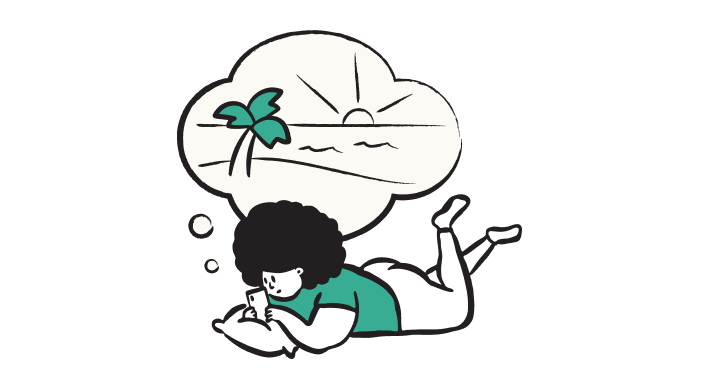Design thinking in the Age of AI
AI is transforming how we live, work, and communicate. With AI’s help, we can move from idea to product launch at super-speed. Never before have we been able to move
▪ September 26, 2025▪ September 19, 2022
Establishing a roadmap of new features and concepts for your digital product is challenging, especially when your team is focused on meeting near-term deadlines and benchmarks. You might have a backlog of product ideas, but these have the potential for being either too far removed from customers, or too incremental in how they will affect your product.
You can look to your technological capabilities and business priorities to decide what’s next. But there’s a missing piece: Your customer’s perspective.
What do your customers want? What is your product lacking that they need?
To find the answers, look to customer diary studies – a tool used in qualitative research to understand users’ behaviors and experiences over time. And when it comes to planning your product strategy? A dark horse.
The best way to fuel your product roadmap is to let your customers lead the way.

A powerful research method, diary studies have your existing or potential customers document aspects of their lives over some time. The entries shed light on how customers behave, think, and feel (either around your product, a process, or topic), and help you see customers’ situations first-hand.
When your team needs a new perspective or inspiration for bigger ideas for future growth, using diary studies can ensure your product:
Diary studies can be conducted using multiple formats that capture participants’ written, image, or video responses. They can be completed over days, weeks, or longer.
The activities could range from having diary participants capture snapshots of their day-to-day, to rating elements of their experience as they go through a service, to taking a video sharing their perspective – depending on your goals and what you want to learn. Digital platforms like dscout and indeemo are designed to help capture and organize participants’ responses.
[contentupgrade id=”2601″]
Like getting a new glasses prescription, a diary study can help you see more clearly. It requires you to take off your product goggles (and your business ones, too). And sure enough, you get a totally different perspective because you’re seeing your product and its opportunities through your customers’ eyes.
You can craft your diary study to explore key questions about your product or service that will inform bigger strategy and design decisions.
The questions you have about your customers may fall into one of three categories:
1. How your customers use and view your product
2. How your product folds into the ways they do things
3. Their views on broader topics related to your product
Digging into the most valuable questions will keep your study focused and provide the most relevant direction for your roadmap. Need some inspiration? Take a look at some possible questions that a diary study could explore for a vacation planning app.

How your customers use and view your product

How your product will fold into the way they do things

Their views on broader topics related to your product
Diary studies can help you investigate questions that are otherwise difficult to answer without a direct lens into customers’ experiences.

Your customer diary study will generate mountains of rich data. You’ll learn things that you never considered to be factors in customers’ decisions or behaviors. You’ll likely have your assumptions proven wrong at some point, and you’ll likely unlock some new ideas inspired by real customer stories about how to take your product strategy further.
Beyond those a-ha! moments, you can use the data from your diary study to develop strategy frameworks that lay the foundation for product development and ideation. These can include:
While you may design your diary study to explore possible customer journeys or personas, be aware that you may find insights that point to equally or more meaningful frameworks that are more useful to your particular product.
For example, imagine that one of your research objectives in conducting a diary study around grocery shopping is to develop personas. After conducting the study, you may find an unexpected insight around how diary participants think about different kinds of shopping trips (like a quick milk and bread run versus meal planning for a week). Creating a framework of shopping trip mental models may have more design implications for your product than the personas you set out to uncover.
Bottom line? Always listen to the data.
You’ve completed your diary study and have the data in hand. Now it’s time to share the findings with your team and glean the gems. And you have various options for how to bring everyone together to define product strategy implications and generate ideas.
Viewing Sessions
Storytelling Presentations
Ideation Sessions
Get a new perspective on your product and find inspiration that will seed bigger ideas. Put diary study data to good use and make sure your product’s roadmap keeps your customers in the driver’s seat.
Everyday Industries is a UX strategy and digital product design firm. Learn how our UX research services can give you an in-depth understanding of your customer’s needs and motivations.
AI is transforming how we live, work, and communicate. With AI’s help, we can move from idea to product launch at super-speed. Never before have we been able to move
▪ September 26, 2025Customer journey maps for wellness tech products are powerful tools to strengthen the digital experience and increase adoption. No matter where you are in developing your product, you can use strategies to uncover and shape the customer journey to ensure the most important elements of the experience are accounted for and thoughtfully defined.
▪ February 16, 2024If your goal is a user-centered product, analysis of your user research is an important step in defining the details that will align your product with users’ needs. Learn a process for data analysis that will make decision-making and design more effective.
▪ December 7, 2023